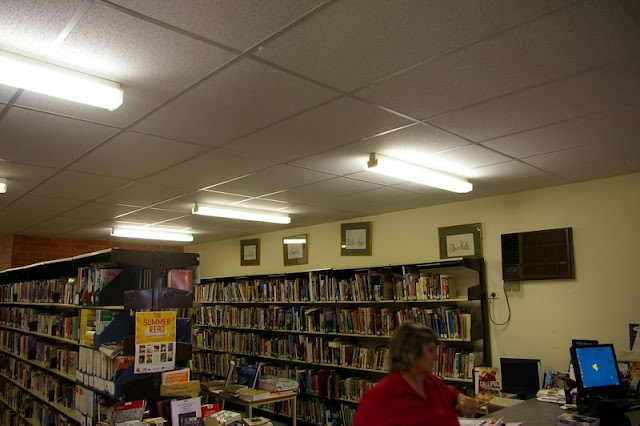A basic first step for these buildings in our climate is to improve insulation where possible.
Most of the roof/ceiling system for Community Complex building is poorly insulated. The existing roofing / ceiling system would have a combined R value of about R 0.6 or less. With only 50mm air space between the top of the ceiling panels and the roof decking, there is no room to add much insulation. The cost of raising the whole roof about 200mm to accommodate insulation was investigated, and found to be too expensive.
So what was the best we could do with the existing roof and ceiling, given the way the building is used?

Trevor working on the roof over the Supper Room. Only 50mm air space between the top of the strawboard ceiling panel and the bottom of the metal decking. Cork had been laid to insulate the steel beam from the decking, but this either never worked or had stopped working.
The 50mm compressed strawboard ceiling panels, although only rated as R 0.62, are not too bad for a building that is usually only occupied [and heated / cooled] for short periods. However the steel I beam that carries these strawboard panels transmits heat and cold from the roof decking into the ceiling below. On a hot day the exposed internal edge of the steel I beams in the ceilings would become too hot to touch – probably about 60 degrees, and radiate heat into the room.
Most of the heat part of this problem was solved with heat reflective paint. This was one of the single biggest and most cost effective impacts we have had on the operation of this building. For more details see Deflect Unwanted Heat on this blog.
Timber Cover Strips
However the heat reflective paint does not help to keep heat in the building in winter. The building is often empty and unheated, is only used for occasional events, and so is only heated for short periods, usually 4 hrs or less. The strawboard ceilings give quite acceptable insulation for short period use. It probably takes more than four hours for much heat to begin passing through the panels. The metal beams can still radiate cold from outside to in, though. While not a perfect solution, our compromise was to cover the exposed internal edge of the metal beams with timber boards.
However the heat reflective paint does not help to keep heat in the building in winter. The building is often empty and unheated, is only used for occasional events, and so is only heated for short periods, usually 4 hrs or less. The strawboard ceilings give quite acceptable insulation for short period use. It probably takes more than four hours for much heat to begin passing through the panels. The metal beams can still radiate cold from outside to in, though. While not a perfect solution, our compromise was to cover the exposed internal edge of the metal beams with timber boards.
 Yuta and Trevor fixing timber cover strips to the exposed internal edge of the steel roof purlins in the Supper Room. These timber strips have also been applied in the Kitchen, Community House, Main Hall, and Foyer.
Yuta and Trevor fixing timber cover strips to the exposed internal edge of the steel roof purlins in the Supper Room. These timber strips have also been applied in the Kitchen, Community House, Main Hall, and Foyer.Insulation above ceiling tiles
The Meeting Rooms area has a different ceiling system, of suspended acoustic ceiling tiles. There was no insulation over these, and only about a 40mm thick roofing blanket jammed between the decking/sarking, and the roofing purlins.
It seemed that the obvious thing to do was to add bulk insulation above the existing ceiling tiles. However replacements for the existing ceiling tiles are no longer available, and it was going to be impossible to work on these tiles without damaging some of them. Plus working on the old ceiling tiles required care and patience, which comes easily to some tradespeople and builders, but not all.
Companies offered to replace all of these ceilings, which would have been wasteful. We don't just want to Reduce, Re-use and Recycle. We need to Refuse, Reduce, Re-use, Repair, Recycle, Re-invent... and so on. (Reconnect, Relocalise...)
So we dismantled and replaced the existing ceiling from the main Meeting Room, only, and salvaged the good tiles from this area to replace tiles in the meeting rooms foyer, VTAG, and RSL rooms.

Meeting room with old ceiling tiles removed, showing only thin roofing blanket insulation under the decking. Rob and Luke from Total Plaster Supplies are about to install new ceiling tiles, and place insulation above these. Ceiling height is immediately above the window and air conditioner.
 Aldo Borg helped to dismantle the old ceiling tile framing, as he had a use for it in insulating his shed. This was a big bonus for our efforts to avoid waste.
Aldo Borg helped to dismantle the old ceiling tile framing, as he had a use for it in insulating his shed. This was a big bonus for our efforts to avoid waste.
Mike (obscured) and Paul Larkin putting the old light fittings into the new Meeting Room ceiling. The bulk insulation above the tiles can be seen at the top of the picture.

Gaspard (obscured) and Yuta placing bulk insulation above the old ceiling tiles in the meeting rooms foyer, and replacing damaged tiles as they go.
Careful repair and re-use of the old ceiling tiles was much cheaper than replacing the whole ceiling. This contributed to the project having enough money to put a new and insulated tile ceiling in the Library.
Denise at work in the Library, under the newly installed and insulated ceiling tiles.
Double glazing
While the new roof windows were fitted with pre-sealed double glazing, we did not consider it cost effective to retrofit double glazing to existing windows. There were so many other thermal leaks around the building, including active draughts, that were cheaper and more cost effective to address. Also even where rooms do have air conditioning fitted, these are only operated for relatively short periods. A lot of the time the building temperature is not so much different from the outside temperature, so the total heat transfer through the windows is moderate.
David Arnold








1 comments:
Great Writing View!!
I like your best opinion that sharing with us. It help us in taking a decision for ceiling and wall decoration..
Thanks
Cleanable Ceiling Tiles
Post a Comment